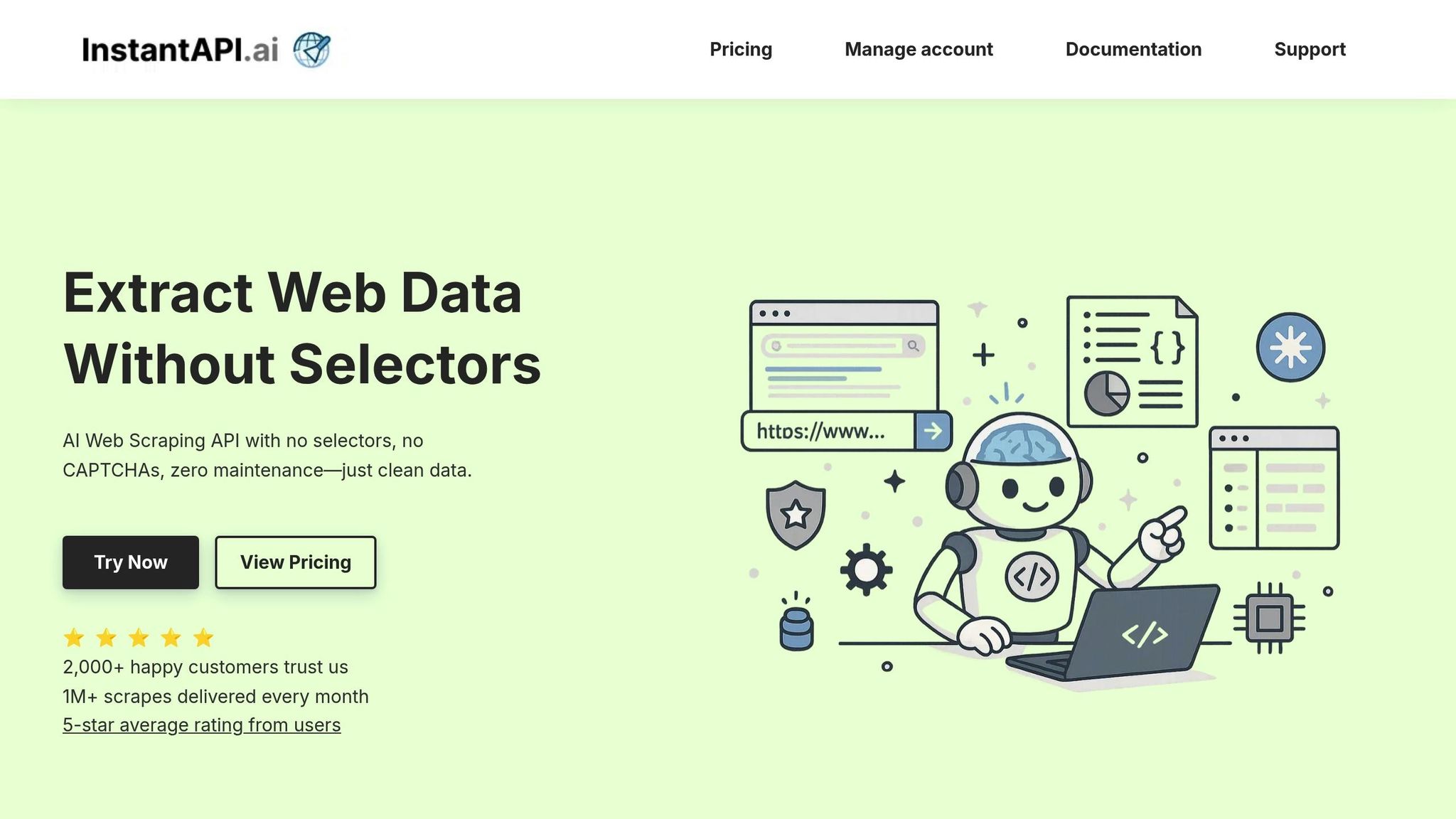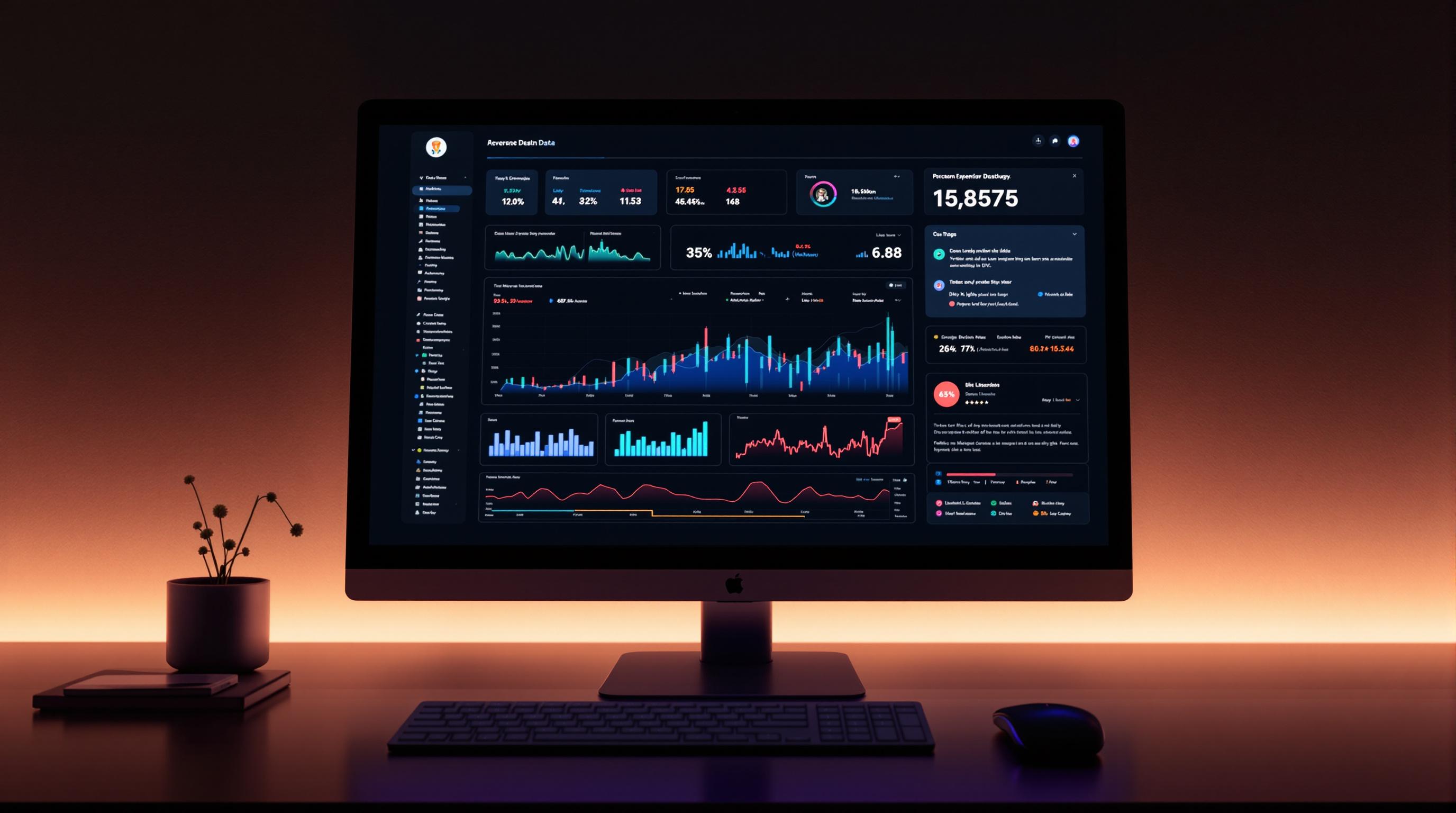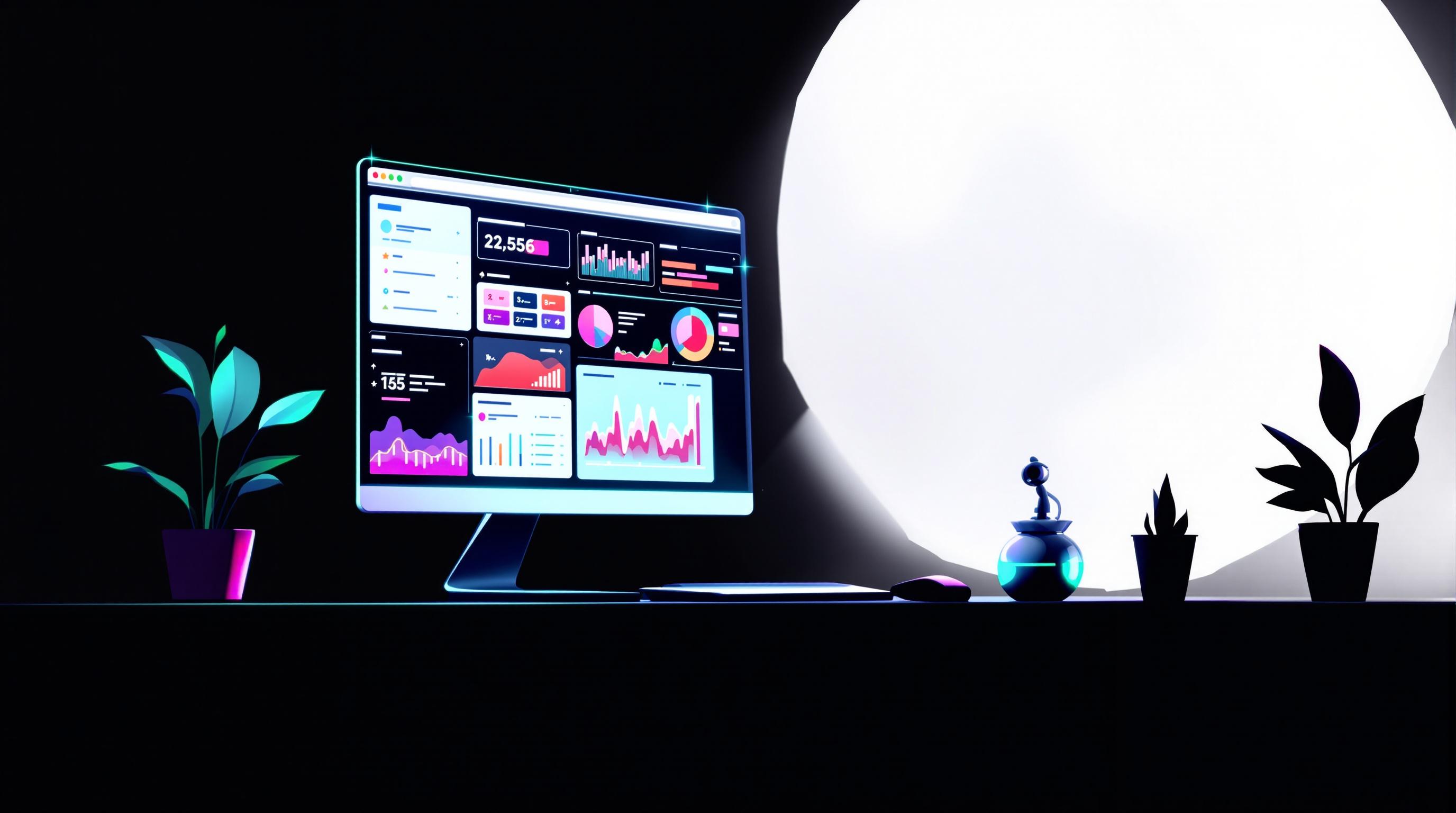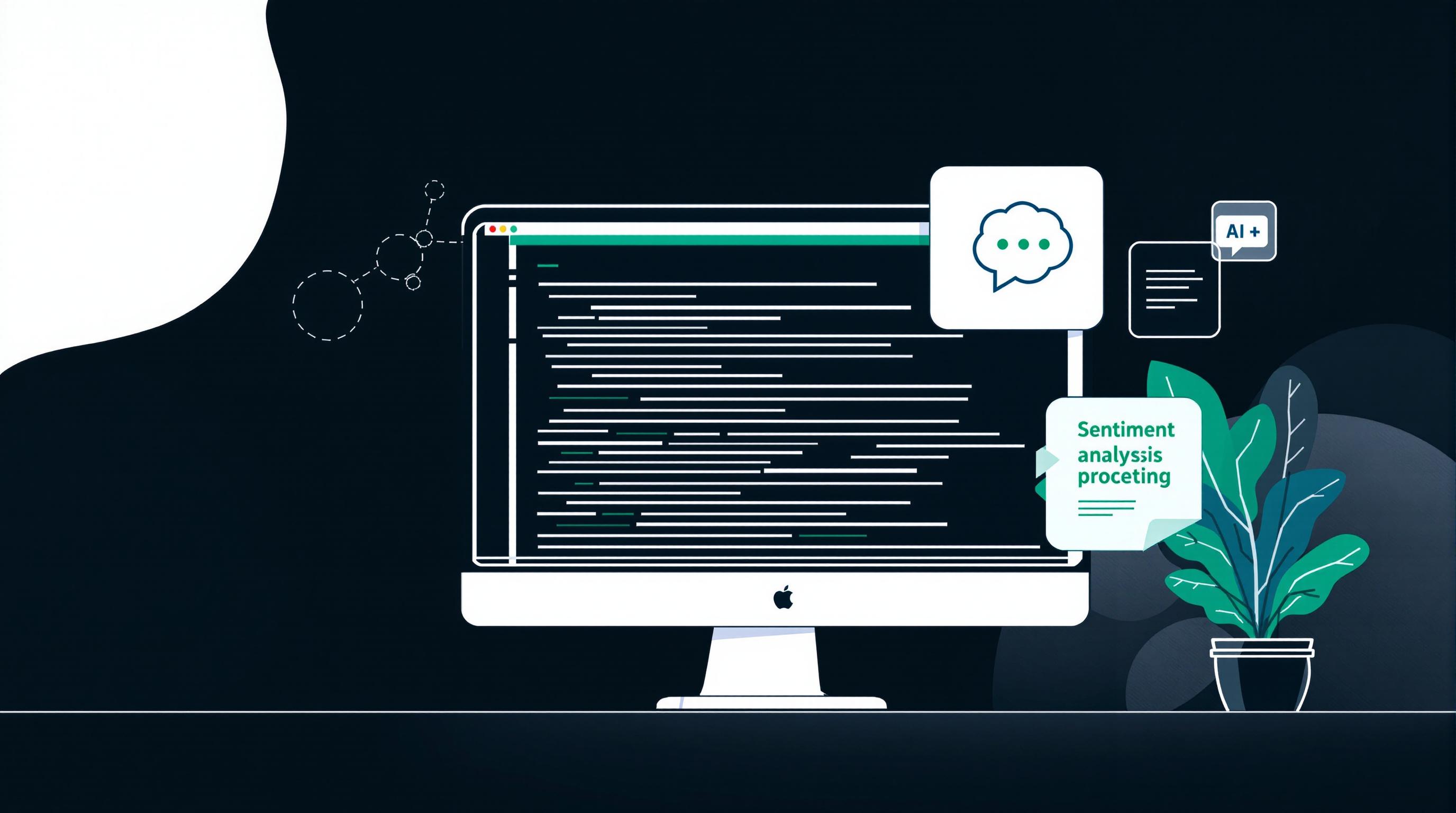Media agencies use web scraping to collect real-time data from websites and social media, helping them understand audience preferences and improve engagement. This approach automates data gathering, providing insights into trends, competitor strategies, and audience behavior without relying on outdated manual research.
Key Takeaways:
- Audience Engagement: Focuses on likes, shares, comments, and viewing time to measure interest.
- Web Scraping Benefits:
- Collects real-time data from social media, competitor websites, and review sites.
- Enables sentiment analysis, market research, and competitive intelligence.
- Helps refine content strategies for better audience connection.
- Challenges with Old Methods:
- Frequent disruptions due to website updates (selector drift).
- Obstacles like CAPTCHAs and IP blocks.
- High costs and inefficiencies in scaling operations.
- Modern Solutions:
- Tools like InstantAPI.ai simplify scraping with JSON-based setups.
- Automatic adaptation to website changes, reducing maintenance time.
- Pay-as-you-go pricing ensures cost efficiency for projects of any size.
Web scraping transforms how agencies interact with their audience, allowing them to create personalized, data-driven campaigns that resonate more effectively.
Main Uses of Web Scraping for Media Agencies
Web scraping has become a game-changer for media agencies, enabling them to harness real-time data for key strategic purposes. Here’s how agencies effectively use this tool to stay ahead in today’s fast-paced digital world.
Collecting Social Media Data
Social media platforms generate an overwhelming amount of engagement data, making manual tracking virtually impossible. That’s where web scraping steps in, automating the process of gathering metrics across multiple platforms at once.
Take Netflix, for example. By scraping social media, they were able to dive into viewer discussions and opinions about their shows and movies. These insights helped them identify what resonated with audiences, shaping future content decisions. Similarly, Coca-Cola used social media scraping to measure the impact of global campaigns. By analyzing sentiment shifts before and after launches, they fine-tuned their strategies to strengthen brand loyalty.
With over 4.48 billion people active on social media, the potential insights are vast. Scraped data allows agencies to track viral trends, monitor competitor mentions, and gauge brand sentiment in real time. This means agencies can analyze posts and interactions faster, gaining a clearer picture of what’s working - and what’s not.
Monitoring Competitor Campaigns
Keeping an eye on competitors is critical, and web scraping provides media agencies with a powerful way to do this. By automating data collection, agencies can track competitor websites, ad campaigns, pricing updates, and promotional tactics.
"Monitoring competitor websites isn't about following the next move; it's about anticipating that move." - Sandro Shubladze, CEO and Founder, Datamam
Web scraping gives agencies a detailed view of competitor activity, from website content updates to social media engagement and customer reviews. This data helps agencies identify gaps in their own strategies and spot emerging trends before they gain traction. For instance, e-commerce retailers use scraping to track competitor pricing, while real estate companies gather market data from property listings.
The automation aspect is key - agencies receive real-time updates and can even set alerts for major changes in competitor strategies. Armed with this information, they can refine their own campaigns and stay ahead of the curve.
Creating Custom Content Strategies
Web scraping turns content planning into a precise, data-driven process. By analyzing scraped data, media agencies can pinpoint the content formats, topics, and posting schedules that generate the most engagement across different audience segments.
For example, Actowiz Solutions used machine learning to analyze SKU-level trends, helping refine content strategies and track brand visibility on Q-Commerce platforms. They monitored SKU positioning, share of shelf, and promotion frequency in real time, delivering actionable insights.
Agencies also scrape forums, review sites, and social media comments to uncover audience pain points and common questions, directly informing their content creation. By analyzing engagement metrics, they can determine which formats work best on specific platforms - whether it’s videos, infographics, or another medium.
Personalization is another major benefit. By identifying distinct audience segments based on online behavior, agencies can tailor content to meet specific preferences. This level of precision not only boosts engagement but also improves overall campaign ROI.
Problems with Old Web Scraping Methods
Older web scraping techniques often turn into a sinkhole for time and money, delivering far less value than expected. One of the biggest headaches? Constant disruptions caused by changes in website structures - known as selector drift.
Selector Drift and Maintenance Challenges
Selector drift is a recurring issue with traditional scraping methods. It happens when websites update their structure, breaking the scrapers that rely on specific HTML elements. This problem is more common than many agencies anticipate, creating an endless cycle of maintenance instead of focusing on the data itself.
Websites frequently revamp their layouts, navigation, and content to improve user experience, follow design trends, or tighten security. For example, a social media platform might overhaul its interface, or an e-commerce site could reorganize its product pages. When these changes occur, the scrapers fail, leaving teams scrambling to repair or rebuild their extraction tools. Entire sprint cycles are often consumed by these fixes, pulling resources away from data analysis.
The problem worsens when agencies scrape data from several platforms. Each site has its own update schedule, leading to unpredictable failures across multiple data points. Managing this chaos becomes a full-time job, draining resources and increasing frustration.
Proxy and CAPTCHA Obstacles
Modern websites are equipped with advanced anti-bot defenses, making traditional scraping methods less effective. Techniques like IP blocking, CAPTCHAs, and browser fingerprinting are common barriers that older scraping systems struggle to bypass.
While bots today can solve some CAPTCHAs with near-perfect accuracy, humans only succeed between 50% and 86% of the time on traditional CAPTCHA tests. For media agencies, frequent CAPTCHA interruptions and IP blocks disrupt the flow of data collection. This creates additional costs, especially for large-scale projects that need to monitor social media activity or competitor campaigns in real time.
To work around these roadblocks, agencies often rely on external proxy services and CAPTCHA-solving tools. But these add layers of complexity, requiring teams to juggle multiple vendors and integrations. Each of these components introduces new points of failure, making scaling operations even more difficult.
Scaling and Cost Inefficiencies
Traditional scraping methods also falter when it comes to handling sudden spikes in demand. For example, when a new campaign launches or a trending topic emerges, agencies need to quickly ramp up data collection. Unfortunately, older systems aren’t built to scale efficiently, leading to expensive infrastructure overhead.
Managing infrastructure adds another layer of complexity. Options like bare metal servers may offer predictable costs but lack flexibility, while cloud-based virtual machines are more adaptable but come with higher per-unit expenses. Agencies often end up locked into costly monthly contracts or seat licenses that don’t align with their actual usage.
In 2024, 65% of enterprises used web scraping to fuel AI and machine learning projects. However, older methods weren’t designed to handle the scale required for these advanced use cases. When agencies attempt to expand their operations for real-time insights or advanced analytics, they quickly run into limitations around cost, reliability, and maintenance.
These outdated tools struggle to handle sudden surges in data demand, such as during a high-profile campaign. This lack of flexibility forces agencies to rely on rigid, expensive infrastructure, all while increasing the burden of maintenance. It’s a system that simply can’t keep up with modern needs.
Current Web Scraping Tools for Media Agencies
Web scraping tools have come a long way, solving many of the challenges that earlier methods faced. Today’s solutions eliminate the hassle of managing custom scrapers and provide dependable, scalable ways to extract data - something media agencies can truly rely on.
Automated Data Extraction with InstantAPI.ai

InstantAPI.ai is changing the game by removing the need for manual selector coding. Instead of wrestling with HTML selectors or complex logic, users simply define what data they need using a straightforward JSON schema. Point the tool at any public URL, and it delivers clean, structured JSON - no CSS selectors or XPath expressions required.
The platform uses machine learning to handle website updates automatically, which means agencies don’t have to constantly fix broken scrapers. This lets teams spend more time analyzing audience engagement and less time on tedious maintenance.
The structured JSON output is ready to integrate with analytics platforms, dashboards, or content management systems, making it easier to turn raw data into actionable insights. And with pricing set at $2 per 1,000 pages, it’s affordable for everything from small projects to large-scale operations.
Scaling Across Multiple Platforms
Modern scraping tools, like InstantAPI.ai, are built to work across a wide range of digital platforms. This platform-agnostic approach is invaluable for media agencies that need to monitor audience engagement across social networks, news sites, and competitor websites - all from a single tool.
For example, agencies can reuse the same API structure to track new competitors or expand their monitoring efforts to additional platforms. This saves time and effort, especially when new trends emerge or when the scope of a project grows.
The pay-as-you-go model is another advantage, allowing agencies to manage sudden spikes in data demand - like during a viral campaign - without worrying about extra infrastructure costs. This flexibility is particularly useful for agencies juggling multiple clients across different industries. Whether it’s tracking fashion trends on Instagram, monitoring sentiment in tech news, or analyzing competitor pricing, a single tool can handle it all without requiring separate setups or vendor contracts.
Following Ethical and Legal Data Collection Rules
Modern web scraping platforms are designed with compliance in mind, helping media agencies navigate ethical and legal guidelines. These tools often include features that ensure adherence to rules like respecting robots.txt directives and complying with data privacy regulations such as CCPA and GDPR.
For example, when collecting user-generated content from social media, it’s crucial to handle personal information carefully. Many tools now offer features to identify and manage sensitive data during the extraction process.
Agencies should also prioritize data quality by implementing checks like validation, deduplication, and cross-referencing with reliable sources. Current tools often provide metrics and error reports, allowing teams to address issues quickly and ensure the data’s accuracy.
It’s equally important to use scraped data responsibly. Agencies should avoid accessing content behind paywalls or login barriers without proper permissions. Transparency about data collection practices can also help maintain trust.
sbb-itb-f2fbbd7
Comparison of Web Scraping Solutions
When it comes to web scraping, choosing the right approach can make or break your data collection strategy. Each method has its own strengths and weaknesses, especially when it comes to setup time, maintenance, and overall costs.
Traditional methods, for example, require serious technical skills and ongoing effort. Teams often spend weeks crafting custom scrapers using Python frameworks like Scrapy or Selenium. And the work doesn’t stop there - every time a website changes its structure, the extraction logic needs to be updated, which can be a frustrating and time-consuming process.
On the other hand, point-and-click tools seem like an easy alternative, offering a “no-code” solution. But these tools often stumble when faced with challenges like infinite scroll or CAPTCHA protections. While they simplify the initial setup, their reliance on fragile XPath outputs can quickly turn into a maintenance headache.
Standalone proxies offer another option, but they only address part of the problem. While they help with accessing data, agencies still need to write their own code for parsing and monitoring data quality. This approach often means juggling multiple vendors and integration points, adding complexity rather than reducing it.
Here’s a quick breakdown of these methods compared to modern platforms like InstantAPI.ai:
Comparison Table of Scraping Methods
| Feature | Traditional Web Scraping | Point-and-Click Tools | Standalone Proxy Services | InstantAPI.ai |
|---|---|---|---|---|
| Setup Time | 2-4 weeks for custom builds | 1-2 days for simple sites | 3-5 days for integration | Minutes with JSON schema |
| Technical Expertise | High (Python, HTML, CSS) | Medium (GUI, XPath) | High (custom coding) | Low (JSON schema definition) |
| Ongoing Upkeep | High (frequent updates) | Medium (config updates) | High (custom maintenance) | None (automatic adaptation) |
| Scalability | Limited by infrastructure | Limited by tool constraints | Good for access, limited for extraction | Unlimited, pay-per-use |
| Cost Structure | High upfront and ongoing | Subscription + maintenance | Proxy fees + dev costs | $2 per 1,000 pages processed |
| Anti-Bot Handling | Manual proxy rotation | Limited protections | Good proxies, no CAPTCHA | Automatic proxies + CAPTCHA |
| Integration Flexibility | Custom APIs needed | Limited export formats | Custom integration required | Standard JSON, works anywhere |
| Compliance Features | Manual setup required | Basic robots.txt respect | None | Built-in privacy controls |
As the table shows, modern platforms like InstantAPI.ai simplify the entire process. Instead of spending time coding and maintaining scrapers, agencies can define what data they need, and the tool handles the rest. This no-selector approach is a game-changer, as it automatically adapts to website changes without requiring any manual intervention.
The pricing model is also a big advantage. Instead of paying fixed monthly fees regardless of usage, agencies only pay for the pages they process. This flexibility works for both small projects and large-scale campaigns. For instance, monitoring 50,000 competitor pages per month would cost just $100 with InstantAPI.ai. That’s a straightforward, usage-based pricing model that’s hard to beat.
"The real differentiators are how they handle compliance, scale, complexity, and partnership. A true industry leader will not just extract data. They'll elevate your entire digital intelligence strategy." - Afaqu Hyder, Author, PromptCloud Inc
For media agencies managing multiple clients and ever-changing needs, InstantAPI.ai offers a stress-free solution. Instead of wrestling with broken scrapers or proxy rotations, teams can focus on what really matters - analyzing audience behavior and crafting smarter content strategies.
Conclusion: Better Audience Engagement with Web Scraping
Web scraping has reshaped how agencies connect with their audiences by offering real-time insights into social media trends, competitor strategies, and audience behaviors. These insights empower agencies to stay ahead in a competitive market.
In today’s marketing world, personalization and targeted messaging are no longer optional - they’re key to success. By using scraped data, agencies can pinpoint the type of content that resonates with specific audience groups, allowing them to create messages that feel timely and relevant. This approach not only increases engagement but also drives conversions and builds stronger brand loyalty. That said, older scraping techniques often fell short of delivering these benefits.
In the past, traditional methods demanded extensive custom coding and constant upkeep, which drained resources and shifted focus away from strategy. Managing proxies and solving CAPTCHA challenges turned what should be a simple task into a time-intensive engineering effort.
Modern tools like InstantAPI.ai have changed the game. With straightforward JSON schema setups and pay-as-you-go pricing, these platforms make data collection faster and hassle-free. This means agencies can spend less time wrestling with technical obstacles and more time analyzing data and crafting impactful campaigns.
By adopting modern web scraping solutions, agencies can shift their energy from managing tools to refining their engagement strategies. This transition from technical problem-solving to strategic planning is where real growth happens.
For agencies aiming to thrive in today’s fast-paced digital world, dependable web scraping is no longer just an option - it’s a necessity. It’s the key to delivering data-driven, personalized campaigns that achieve tangible results.
FAQs
How do media agencies use web scraping to improve audience engagement?
Web scraping enables media agencies to enhance audience engagement by delivering real-time, detailed insights into audience preferences, behaviors, and emerging trends. Unlike older methods of data collection, which often take more time and require significant resources, web scraping quickly pulls fresh information from platforms like social media, competitor websites, and online forums.
With this data in hand, agencies can craft highly personalized and targeted content strategies that connect with their audiences on a deeper level. For instance, they can identify trending topics, keep tabs on competitor campaigns, or analyze audience feedback to refine their messaging on the fly. This adaptability helps keep campaigns relevant and impactful, boosting engagement and building stronger audience loyalty.
What legal and ethical guidelines should media agencies follow when using web scraping tools?
Media agencies in the United States face a balancing act when it comes to using web scraping tools, as they must weigh both legal and ethical factors. Legally, while web scraping isn’t outright banned, scraping personal data without consent can run afoul of privacy laws like the California Consumer Privacy Act (CCPA). On top of that, scraping a site in violation of its terms of service could spark legal challenges. To stay on the right side of the law, agencies should work closely with legal experts to ensure their practices align with all relevant regulations.
On the ethical side, agencies should steer clear of gathering sensitive or private information and respect intellectual property rights. It’s also crucial to avoid activities that could compromise user privacy or disrupt a website’s functionality. By sticking to transparent and responsible methods, agencies can safeguard their reputation and build trust while minimizing potential risks.
How do modern web scraping tools like InstantAPI.ai solve issues like selector drift and scaling that traditional methods face?
Modern web scraping tools, such as InstantAPI.ai, tackle common hurdles like selector drift and scaling by using AI to automatically adjust to changes on websites. This means users no longer need to manually update scrapers, ensuring smooth and uninterrupted data extraction.
These tools also make scaling straightforward by offering features like unmetered scraping, premium proxies, and JavaScript rendering. With this setup, users can efficiently gather data from nearly any website, even those with dynamic content or strong security defenses.


